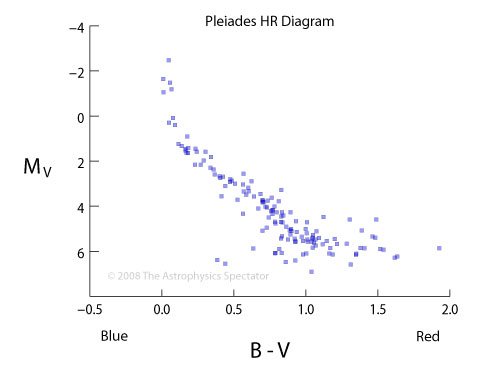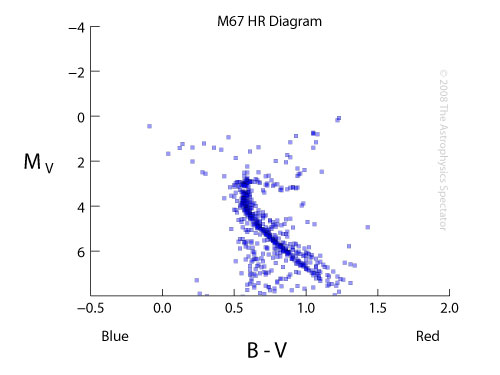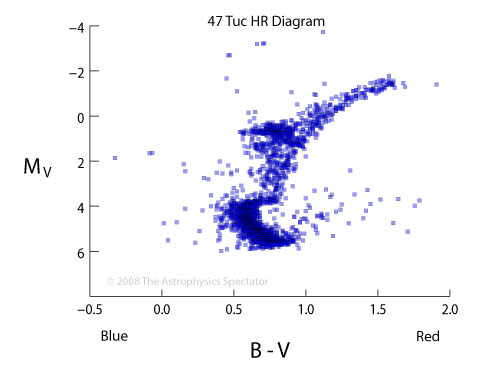
The Astrophysics Spectator
The field stars we see in the Galactic disk are a mixture of stars of all masses and ages. When the nearby field stars are plotted on a Hertzsprung-Russell Diagram, they appear as two groups: the main-sequences stars, and the red giant star. Such a diagram betrays that stars are power by two fuels?hydrogen and helium?but it does not tell us how a star that has exhausted its core hydrogen moves from the main sequence to the red giant group.
Fortunately, nature often creates stars in batches. These stars form gravitationally-bound clusters that can persist for billions of years. The very massive globular clusters generally formed in the Galaxy's early years. Open clusters formed within the Galactic disk in more recent times. The stars in these clusters provide us with a snapshot of how stars move from the main-sequence to the red giant group.
The open clusters are young, so they show us how stars appear after several hundred million years of evolution. Only the very heavier stars have moved away from the main sequence in the youngest of these clusters. Stars similar to Sirius in luminosity (absolute visual magnitude of 1.4) are still on the main-sequence in young clusters. Many of the luminous stars of the oldest open clusters, which are a couple of billion years old, have left the main-sequence and are moving across the diagram to the red-giant region. The HR diagrams of the open clusters therefore show us how the stars more massive than the Sun evolve as they age from 100 million years to several billion years.
The nearby Pleiades open cluster (Messier 45, also called Mellotte 22), whose brightest stars are conspicuous on the sky, is very young. The youth is implied by the cluster's Hertzsprung-Russell diagram, which is given below. The Pleiades cluster is one of the closest open clusters to Earth, with a distance of only 118 parsecs (Robichon et al. 1999).[1]
The stars in the Pleiades are all on the main sequence. Comparisons of the shape of the main-sequence to the shape predicted by stellar evolution codes give the young age of 100 million years for the cluster. This time is insufficient for the stars in the cluster to consume their hydrogen and evolve into red giants. For this reason, all of the stars on the HR diagram lie near the main-sequence.
The first point to note is that the main sequence for the Pleiades cluster is very narrow, unlike the main sequence for the nearby stars. This narrowness reflects the fact that all the stars in the Pleiades cluster are the same age. As they age, they move as a group to higher luminosities and redder colors, but they preserve their narrow distribution on the HR Diagram. The evolution to higher luminosities and redder colors is most apparent in the handful of stars with absolute visual magnitude MV < 1 (for those unfamiliar with magnitudes, the smaller the magnitude, the brighter the star). These stars are on the red side of the main-sequence. In contrast to the HR Diagram for the Pleiades, the HR Diagram for the nearby stars has numerous main-sequence stars with negative color indices (B?V).

The Hertzsprung-Russell Diagram for 145 stars of the Pleiades open cluster. The vertical axis is absolute visual magnitude (MV), and the horizontal axis is color index, which is apparent magnitude in the B (blue) band minus the apparent magnitude in the V (visual) band. The data on this plot are for stars at the position of the cluster and with velocities that suggest membership in the cluster with 50% certainty. The data is taken from Kharchenko et al. (2004),[2] and they are available through the VizieR service in catalog J/AN/325/740/csoca.
When one looks at the Hertzsprung-Russell diagram for the very distant open cluster Messier 67 (NGC 2682), one sees a much different distribution of stars. This cluster is much older than the Pleiades cluster, and the luminous stars within M 67 have had time to move away from the main sequence. Comparing the results of stellar evolution codes to this HR diagram, astrophysicists estimate the age of this cluster to be around 2.6 billion years, or over half the age of the Sun.
The deviation of the stars of M 67 from the main sequence is most pronounced for the stars with B?V of 0.5. Stars crowd together at this color over the range of 2 to 4 in absolute visual magnitude; these are the stars that have move to the right on the diagram from the blue portion of the main sequence. Unlike the stars of the Pleiades, the stars of M 67 that are still on the main-sequence are all redder than 0.5. At MV around 3 one sees a hook of redder stars in the diagram. The red end of this hook is the lower edge of the red-giant region. So in 2.5 billion years, the stars in M 67 that have masses similar to Sirius and other nearby, luminous stars have moved way from the main sequence, but stars with masses less than Rigil Kentaurus ( Centauri), which for a mass not much larger than the Sun's has MV = 4.34 and BV = 0.71, remain on the main sequence.

The Hertzsprung-Russell Diagram for stars of the open cluster Messier 67. The diagram contains 637 stars from a survey compete between 12.5 < B < 18.5 and 12.5 < V < 18.5. The distance of the cluster is set to 908 parsecs (Kharchenko et al. 2005).[3] The data is taken from Stassun et al. (2002), which is available through the VizieR service as catalog J/A+A/382/899/table3.[4]
Even at 2.6 billion years of age, which is about as old as an open cluster can become before being tidally disrupted, M 67 is relatively young. The Sun, after all, is 4.5 billion years old, and the universe itself is around 16 billion years old. To find truly old groups of stars, one must turn to the globular clusters, which are much larger than the open clusters, containing of order 1 million stars. Most globular clusters have ages comparable to the age of the Galaxy. These clusters are orbiting the Galactic center out of the Galactic plane; This makes them easy to see despite being many kiloparsecs away. Because they are old, their stars contain few metal, which alters to some extent their evolution relative to the younger and metal-rich stars of the Galactic disk.
Below is the HR diagram for the globular cluster 47 Tuc (NGC 104), which is in the Tucana constellation of the Southern Hemisphere. This cluster is about 4.5 kiloparsecs from Earth. Its absolute visual magnitude is -9.6, which is of order a million times the luminosity of the Sun, with its absolute visual magnitude of 4.83. What is clear from this cluster's HR diagram is that the stars in the cluster are highly-evolved, with the stars of absolute visual magnitude less than 4 having moved far away from the main sequence. As in M 67, the stars in 47 Tuc moved off of the main sequence by moving right to the red region of the diagram. The red giant stars, with magnitudes of 1 and less, are apparent in this diagram. The shape of this HR Diagram suggests that the stars in 47 Tuc are 13 billion years old, which means they 80% of the universe's age.

The Hertzsprung-Russell Diagram for stars of the globular cluster Tuc 47. This diagram contains 2368 stars, taken from several studies consolidated in the database of Philip et al. (1976). The data are avaiable through the VizieR service from the catalog II/37/measures.[5]
The last diagram shows that the main-sequence stars of our galaxy with absolute magnitudes greater than 5 have never left the main sequences. This red, low-luminosity stretch of the main sequence is unevolved for all stars in the Galactic, because the stars on this stretch require many times the current age of the universe to consume their core hydrogen. The stars that have evolved are the massive, luminous stars, stars with masses comparable to the Sun, and stars much more massive than the Sun. These are the stars that have given us the degenerate dwarfs, neutron stars, and black hole candidates that we see throughout our galaxy.
[1]Robichon, N., Arenou, F., Turon, C., Mermilliod, J.C., Lebreton, Y. In HIPPARCOS Venice ?97 ed. B. Battrick, Space Agency Spec. Publ. 402. Noordwijk, The Netherlands: ESA Publ. Div. ESTEC, 1997: 567?570.
[2]Kharchenko N.V., Piskunov A.E., Roeser S., Schilbach E., and Scholz R.-D. ?Astrophysical supplements to the ASCC-2.5. II. Membership probabilities in 520 Galactic open cluster sky areas." Astronomische Nachrichten 325 (2004): 740?748.
[3]Kharchenko N.V., Piskunov A.E., Roeser S., Schilbach E., and Scholz R.-D. ?Astrophysical Parameters of Galactic Open Clusters.? Astronomy and Astrophysics 438 (2005): 1163. Data available online athrough the VizieR service in catalog J/A+A/438/1163.
[4]Stassun, K. G., Van den Berg, M., Mathieu, R. D., and Verbunt, F. ?Photometric Variability in the Old Open Cluster M 67.? Astronomy and Astrophysics 382 (February, 2002): 899?909. Data available online athrough the VizieR service in catalog J/A+A/382/899/table3.
[5]Philip A.G.D., Cullen M.F., White R.E. ?Catalogue of UBV HR Diagrams of Globular Clusters.?
Dudley Observatory Report No. 11 (1976). Available through the VizieR service catalog II/37/measures.
